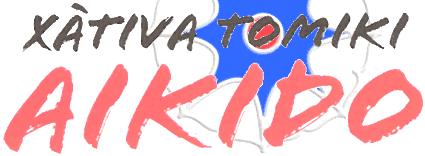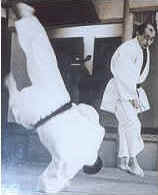|









VALENCIA TOMIKI AIKIDO




|
Website updated
04 Feb 2018
|
| |
|
ELEVENTH YEAR AIKIDO
COURSE - ALMUSSAFES, SPAIN - 27-29th January, 2017 |
|
|
|
Next 27th to 29th of January, 2017 we
will have our annual winter Study Group Seminar in Almussafes, Valencia, Spain. |
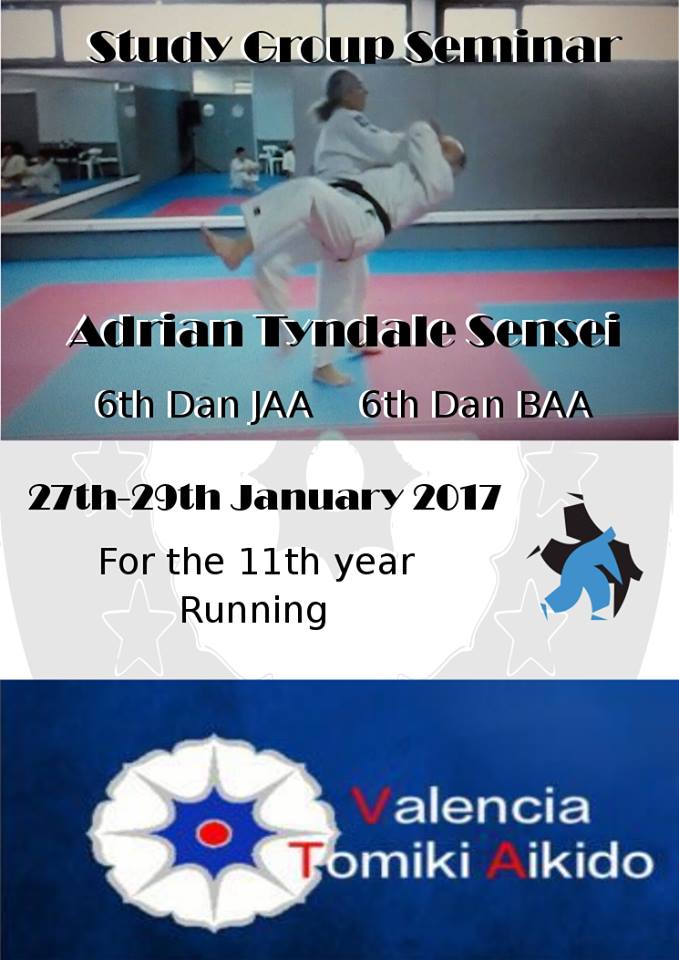 |
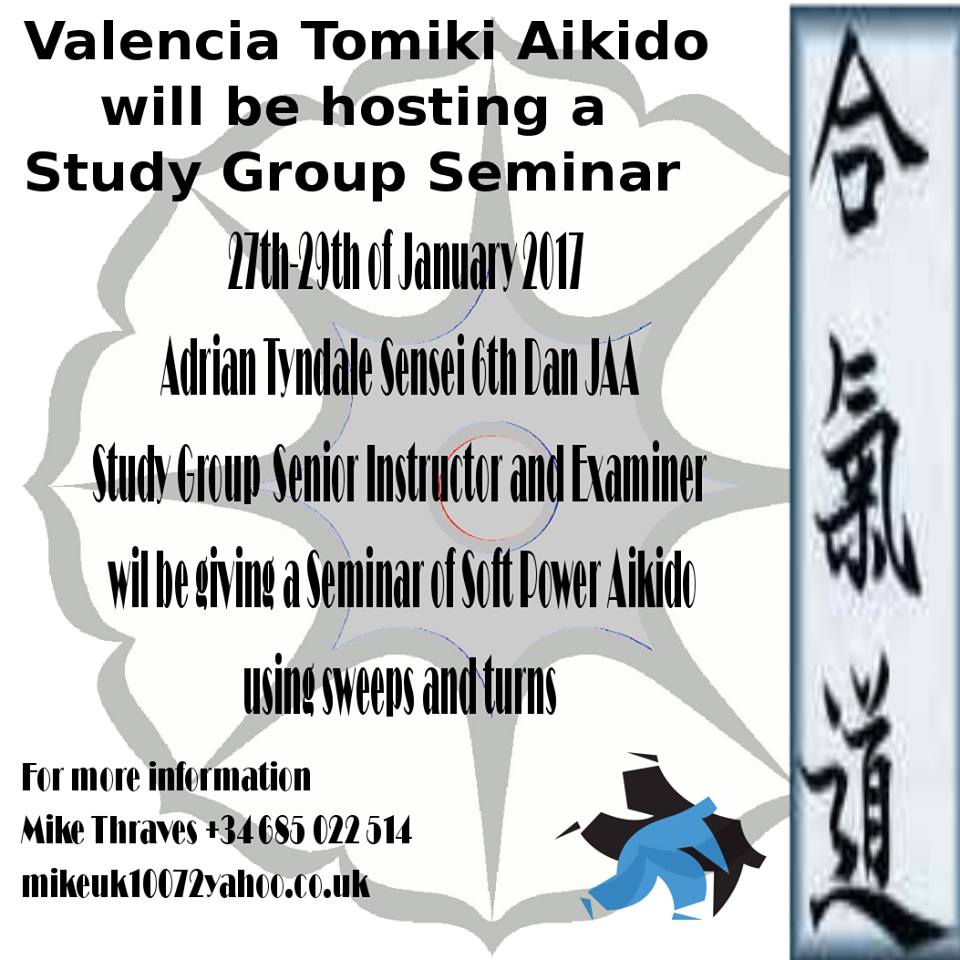 |
|
Recuerde que esta semaņa
tenemos un seminario con Adrian Tyndale
Horarios: El Viernes
19.00 a 21.00
El Sabado 10.00 a 14.00
El domingo 10.00 a 14.00
Cena El Sabado en el
restaurante Atzucac Xativa 20.30
27th to 29th of January,
2017 we will have our annual winter Study Group Seminar in Almussafes,
Valencia, Spain
Remember that this week we
have a seminar with Adrian Tyndale
Schedule: Friday, 19.00
to 21.00
Saturday 10.00 to 14.00
Sunday 10.00 to 14.00
Dinner on Saturday at the
restaurant 20.30 Atzucac, Xativa
http://www.xativa-aikido.co.uk/winter_course_2017.htm
|
|
|
|
STUDY GROUP TOMIKI AIKIDO Friday 27th
January, 2017 - 19.00pm to 21.00pm |
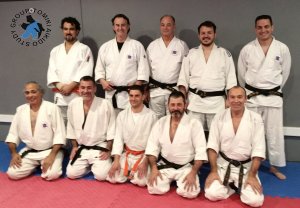 |
The objective of the seminar this weekend
is to study concepts of distance using Aikido/Judo principles. To gain a
better understanding of how the shoulder-line and spine-line can be
implemented to improve the efficiency of our techniques and apply this
to some self-defence applications taken from Aikido Goshin Ho and Judo
Goshin Jutsu.
|
|
Scapula or shoulder blade
These are two wide flat bones that
provide attachment for 3 different muscle groups. In martial arts there
are a wide variety of ways in which we can use the upper back to assist
performance. The seminar this weekend shed some light on how these
benefits can be achieved.
Spine Wave
The spine wave is created by the action
of the Lumbar Spine, the thoracic spine and associated tissues working
sequentially but in harmony with one another. This bowing and un-bowing
of the spine is one very powerful way in which the body can utilize the
spine to create force or power.
Harmony of the Joints
There is a method for identifying the
relationship and the role of our major body joints known as the '3
external harmonies' or sometime the '6 harmonies' depending upon the
tradition. These are the Wrists to the Ankles, The Knees to the Elbows
and the Shoulders to the Hips. There are several idea's linked to this
association. But two of the major ones explain how the joints
align with each other and then their related role within the body.
Winding
Winding can be described as a means to
wrap the fascia, muscles and relevant tissues into tight spirals around
the bones and body structures in order to control the bone movement.
Proprioception or
Position Sense
The five senses: vision (sight), audition
(sound), olfaction (smell), taction (touch), and gustation (taste).
These senses are responsible for our interaction with the external
world. Additionally, we have several senses that are responsible for our
internal functioning. One of the most important internal senses is
called proprioception, or position sense. Proprioception allows humans
to control their limbs without directly looking at them. Human beings do
not have a single organ for proprioception. Instead, the sense is
processed by the entire nervous system as a whole. Inside every muscle
and joint lie tiny meters called muscle spindles and Golgi tendons that
constantly measure the amount of tension and degree of contraction. This
information travels up a discreet highway in the spinal cord called the
spinocerebellar tract, and makes its way to the cerebellum. The
cerebellum accepts information from every muscle and joint in the body,
and calculates where the limbs must be in space.
Ankle
We have an extremely refined balance and
proprioception systems keeping us upright. Most of the correction and
balance maintenance systems work without conscious thought, they simply
activate as and when they are required. The ankle and associated tissues
are central to this system. Tightness in the ankle is one of the most
significant factors inhibiting the ability to root or feel the ground
connection.
|
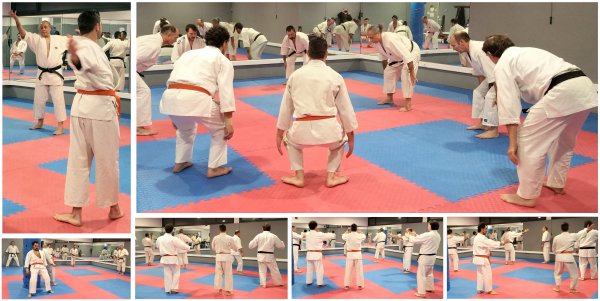 |
|
Our functional warming up relates to the
above -
Ankles, hips, shoulders (Whole
body)
Foot movements (without moving
body)
Foot movements (Ayumi Ashi
training) First slowly "Penguin" or "Mud-Walking".
Then Tsugi Ashi training, left, right, forwards and backwards.
Reciprocating torsional
stretching and rising
Elbows together, Elbows out
(movement from the upper spine - sternum [breast-bone]
Rotating arms forwards
Rotating arms backwards
(In both cases sternum rises and retracts
as the body lets go)
Spinal wave
(Arms out, retract the sternum region.
Retract Lumber region.
Curl spine forwards and down - arms down
palms facing rearwards. Rise up from the sternum, the arms naturally
moving up [shoulders back] then arms forwards [shoulders neutral]
Reciprocating alternate arm
forward exercise
(Here the objective is to bring the elbow
as far as possible across the front of the chest whilst stretching the
arm, palm up. The whole body is rhythmically rising and letting go
whilst performing the exercise)
Lastly, opposing arm rotations.
(This whole-body exercise in the
beginning stimulates the "left" brain to memorise the sequence
with the ultimate aim to perform the movement without thinking;
"right" brain. In its way this exercise mimics the process
used when learning a new Aikido technique.)
|
Foot movements
(Perform first without moving the body,
then in the conventional way with body movement.)
Hand movements
(Modern system but including inside and
outside sweep turn)
Hand movements (Tsugi Ashi
training)
Shomen
Ate
Inside
Sweep
Outside
Sweep
Combined
Inside Turn, Outside Turn
(All left, right, forwards, backwards.
Always in each case stretching the arm then moving the feet)
|
Tegatana Awase.
(Touch hand heel to hand heel at
approximately a 45° angle. Maintain this contact throughout. To start
the pressure will be higher than needed and it will be tiring. With
practice the pressure will reduce. The movement starts with the arm and
the upper body; this accommodates the difference in distance. No
leaning, no buckling the arm or disconnecting at the hand blade. The
correct Aikido distance is always maintained.)
Tegatana Awase into gripping
the wrist.
(Grip from the inside or the outside and
by using either hand.)
When comfortable with this select a
technique from the Basic 17 Atemi Waza section. (Shomen Ate is a
difficult choice!)
These all demonstrate techniques from an
Aikido distance. From a self-defence point-of-view the attacker will try
to close down the distance
|
|
|
|
Five Aigamae grips and five Gyakugamae
grips are used to illustrate this. Implementation of the functional
exercises must be seen within these applications. e.g. Elbows leading
wrists etc.
We moved on to the distance of Judo,
which is where Tori may well end up when attacked in a self-defence
scenario.
JUDO GOSHIN JUTSU NO KATA (Formas de
Autodefensa - Cinco Secciones - 21 técnicas)
Section 4 - Armed Attacks Stick
16 Furiage - Upswing Against A
Stick
At attacker brings the stick up to
strike, defender steps in, blocking the attacking arm, delivering a palm
strike to the chin and throwing attacker backward.
17 Furioroshi - Downswing
Against A Stick
Attacker attempts to strike left side of
defender's head. Stick is avoided by a turning action. Defender
immediately steps in with a back fist strike to the bridge of the nose.
He then controls the stick, and strikes again below the nose with the
edges of his hand forcing the attacker down.
18 Morote Zuke - Two Hand Thrust
Attacker thrusts stick to abdomen.
Defender turns and parries. He then grabs the stick and pulls attacker
forward and steps in to grab stick with both hands. Attacker not wanting
to let go of the stick, pulls back and defender steps forward throwing
attacker with his own stick.
Warming Down
Stretching
|
|
STUDY GROUP TOMIKI AIKIDO Saturday
28th January, 2017 - 10.00am to 14.00pm |
|
Functional warming up -
Ankles, hips, shoulders (whole
body)
Reciprocating torsional
stretching and rising
Elbows together, Elbows out
Rotating arms forwards
Rotating arms backwards
Spinal wave
Reciprocating alternate arm
forward exercise
Lastly, opposing arm rotations
|
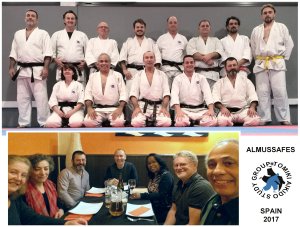
|
|
Foot movements
Hand movements (modern system but
including inside and outside sweep turn)
Stability Training (Slow
"Penguin" walking)
Tsugi Ashi Training (Feet only, then with
arms)
Tegatana Awase
(Moving then Grip and then a technique
from Basic 17)
(Try the same with the six grips from
Shichi No Hon no Kuzushi.)
(In a fluid way study the action and
reaction which occurs in this scenario.)
The introduction of five additional
techniques:
11 Waki Gatame (Uchi-inside)
13 Kote Hineri (Aigamae
Gyakutedori) - Kote Mawashi
14 Kote Hineri (Gyakugamae
Gyakutedori)
15 Kote Gaeshi (Aigamae
Gyakutedori)
19 Tenkai Kote Gaeshi
(Ura-backwards)
Utilising the Spine
In Paris last weekend we attended a
workshop with Sensei Akira Hino. His ideas oriented on the flexibility
of the spine. Kyokotsu (Thoracic upper spine) and Koshi (Lumbar
lower spine) play an important role. When the spine is used in the
proper way, more power can be generated.
We started with Hand to Hand exercise
from Hino Sensei - (Aikido distance)
We then move onto a Chest to Chest
exercise - (Judo distance)
(Emphasis on top spine curl with Koshi
not moving back)
We used this study to look at how this
might be used to improve the execution of Shomen Ate.
Warming Down
Stretching (In a seated
position, one leg outstretched, the knee of the other leg bent and
crossed over the outstretched leg.)
Gradually lean forward from the hips,
breathing in through the nose out through the mouth. Do this in stages,
whereby each new forward position becomes the starting point.
In the evening, drinks and dinner in
Xativa at the restaurant "Atzucac"
|
|
STUDY GROUP TOMIKI AIKIDO Sunday 29th
January, 2017 - 10.00am to 14.00pm
|
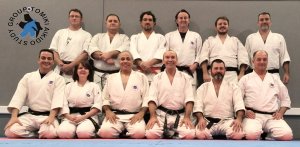 |
Functional warming up -
Ankles, hips, shoulders (whole
body)
Reciprocating torsional
stretching and rising.
Elbows together, Elbows out.
Rotating arms forwards.
Rotating arms backwards.
Spinal wave.
Reciprocating alternate arm
forward exercise.
Lastly, opposing arm rotations.
|
|
Foot movements
Hand movements (modern system but
including inside and outside sweep turn)
Tsugi Ashi Training (Feet only, then with
arms)
Tegatana Awase
More Judo Goshin Jutsu
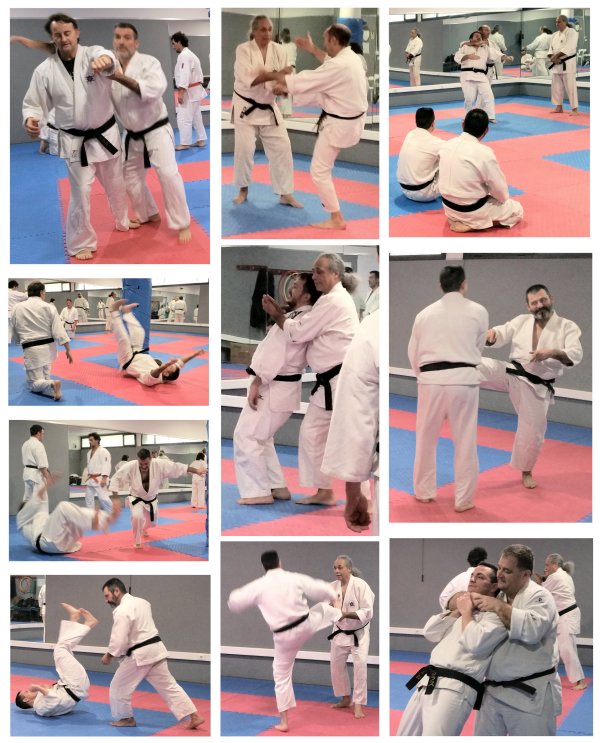
Section 2 - Unarmed Attacks At A Distance
8 Naname Uchi - Slanting Strike
Attacker attempts to strike the left side
of head. Strike is parried and countered with an uppercut and throat
grab, forcing a take down or throw to the attacker's rear.
9 Ago Tsuki - Uppercut
Attacker attempts an uppercut that is
parried by defender. Attacker's arm motion is redirected against his
elbow and turned into a throw by this action.
10 Gammen-Tsuki - Thrust Punch
or Jab
Attack is again parried and a counter
attack is made by a punch to attacker's floating ribs. Defender then
applies a rear choke forcing submission or unconsciousness.
11 Mae Geri - Front Kick
Defender parries kick by turning body and
hooking leg with arm. He then grabs the foot of attacker's raised leg
with both hands, twisting the ankle, "breaking it", and then
forcing attacker backward and down.
12 Yoko Geri - Side Kick
Attacker attempts a side kick as he
passes defender, who parries the kick turns and pulls attacker down onto
his back. While this technique in the kata looks harmless enough, in
actuality, the defender would leave his knee in place so that defender
falls onto him with his lower back on the knee, which would no doubt
break the attacker's back.
Warming Down
Stretching
After the seminar ended a light lunch and
a time to enjoy the Spanish sun and relax.
And last a "Thank You" to
Michael and Audrey for their hospitality and continued support in this
eleventh year of these seminars in Spain.
|
|
STUDY GROUP TOMIKI AIKIDO SESSIONS FOR
2017 . . .
|
|
18-19Feb2017 Antwerp, BELGIUM and Paris,
FRANCE with Eddy Wolput
18-19Mar2017 Antwerp, BELGIUM with Eddy
Wolput, JAA Grading
29-30Apr2017 Antwerp and Turnhout,
BELGIUM
A joint seminar of Aikikai and Tomiki
Aikido with Eddy Wolput
13-14May2017 Sofia, BULGARIA with Eddy
Wolput
17-18Jun2017 Antwerp, BELGIUM with Eddy
Wolput
19Jun2017-29Aug2017 SUMMER BREAK
30Aug2017-03Sep2017 International Tomiki
Aikido Festival in Akita
07-Oct2017 Antwerp, BELGIUM with Eddy
Wolput
11-12Nov2017 Almussafes, SPAIN with Eddy
Wolput
09-10Dec2017 Antwerp, BELGIUM with Eddy
Wolput
|
STUDY GROUP TOMIKI AIKIDO
- Tradition and
Knowledge
Chief Instructors/Examiners Study Group
Tomiki Aikido
Eddy Wolput 7th Dan (JAA) - JAA-Shihan
Frits van Gulick 7th Dan (JAA) -
JAA-Shihan
Yoshiomi Inoue 7th Dan (JAA) - JAA Senior
Instructor
Instructors/Examiners Study Group Tomiki
Aikido
Adrian Tyndale 6th Dan (JAA/BAA) -
JAA-Shihan Dai - International Silver Medallist
Gina De Weerdt 5th Dan (JAA) - JAA-Shihan
Dai - former European Kata Champion
Koos de Graaff 5th Dan (JAA)
Mike Thraves 5th Dan (JAA) - JAA-Shihan
Dai
Pierre Alain Zeiter 4th Dan (JAA) -
JAA-Shihan Dai
|
|
For those who are
"Facebook-less" we have an alternative way of communicating
our studies via:
STUDY GROUP TOMIKI AIKIDO - Wikispaces
https://study-group-tomiki-aikido.wikispaces.com/
For archived Study Group Tomiki Aikido
reports please see:
http://www.aikidouk.co.uk/study-group-reports.htm
|
|

|
|


